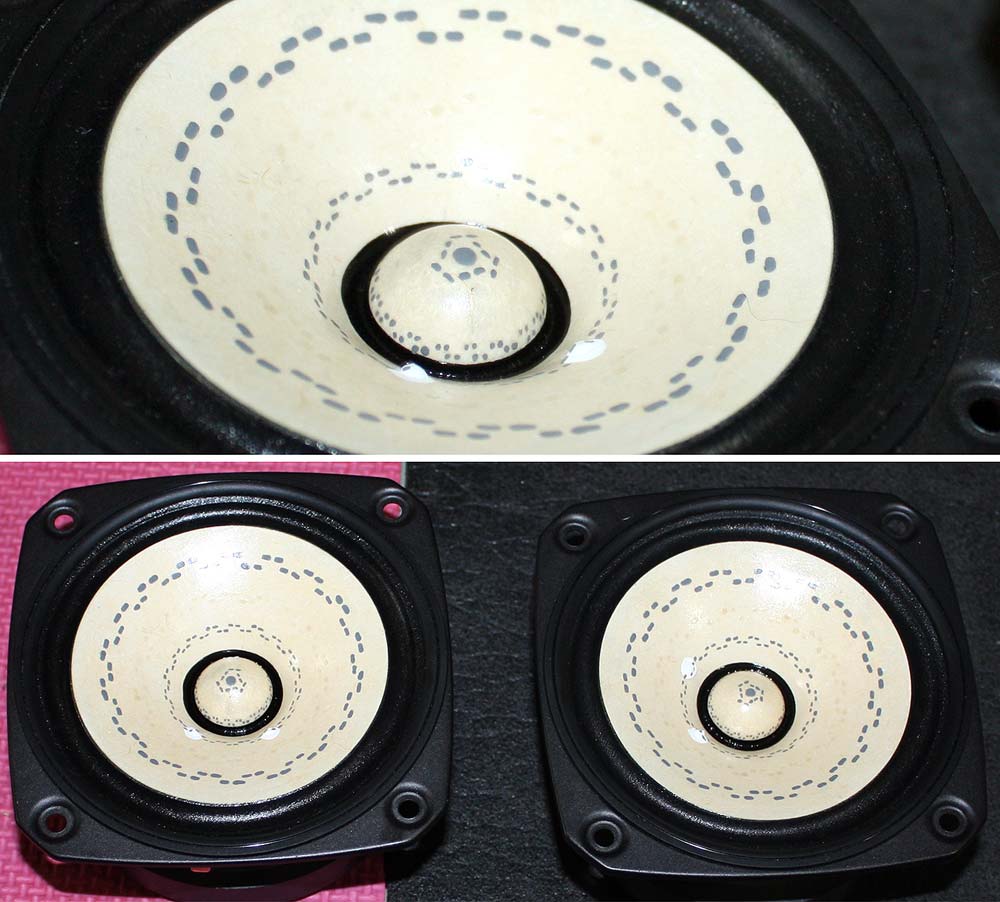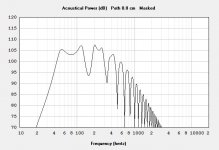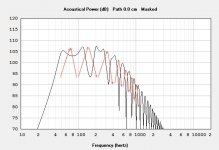Thanks for the comments, GM and Chrisb. That gives me some things to think about. Overall the speakers sound promising, but something somewhere needs to be tamed.
FE126e have some high frequency resonances that bug some people. Althou a bit better the newer driver also has some issues.
If you are into modding the drivers these issues can be reduced significantly. There is a thread somewhere here.
A fully tarted up pair (much is invisible -- these are FE126En, FE126e have an additional step) -- all the steps have been posted. The steps that work the resonance are not the spots, they do something else:

dave
If you are into modding the drivers these issues can be reduced significantly. There is a thread somewhere here.
A fully tarted up pair (much is invisible -- these are FE126En, FE126e have an additional step) -- all the steps have been posted. The steps that work the resonance are not the spots, they do something else:

dave
If drivers are fresh from the box, I'd wager that break-in is certainly part of the issue. The Neutriks are not likely part of the problem, but you could try thinner wire. I can't remember the last time I used anything larger than #18 except in car sub woofers - internal wiring on all my FR driver builds is single strand of #24 from CAT5 network cable.
Howdy Chris,
I'm building a pair of bk12's now, and was curious if you suggest twisting the pair of wires together? It seems it could be easier to manage the run of wire through the cabinet, just not sure if has any detrimental effects.
I've got some spare Kimber dtc23 I could use for it.
Thanks!
As mentioned in prior post in this thread, I generally use very thin wire ( i.e. single strand of #24 per pole) for most of my FR drive builds, and for shorter runs as in little desk top boxes it's a piece of cake to untwist the CAT 5 wire, but when internal lengths are any greater than about 10", I'll leave the bulk of that twisted.
Now's the time for the Sheldon Coopers out there top explain why either approach would be ill advised. 😀
Sorry about the snarky tone in that last bit, I'm a bit of an agnostic when it comes to wire / cable myths - in other words, whatever's easiest and at hand.
Now's the time for the Sheldon Coopers out there top explain why either approach would be ill advised. 😀
Sorry about the snarky tone in that last bit, I'm a bit of an agnostic when it comes to wire / cable myths - in other words, whatever's easiest and at hand.
As mentioned in prior post in this thread, I generally use very thin wire ( i.e. single strand of #24 per pole) for most of my FR drive builds, and for shorter runs as in little desk top boxes it's a piece of cake to untwist the CAT 5 wire, but when internal lengths are any greater than about 10", I'll leave the bulk of that twisted.
Now's the time for the Sheldon Coopers out there top explain why either approach would be ill advised. 😀
Sorry about the snarky tone in that last bit, I'm a bit of an agnostic when it comes to wire / cable myths - in other words, whatever's easiest and at hand.
No need to apologize, I tend to agree. I aim for good quality cable, that's available, and nearest my hands. ha
Thank you for the quick reply!
........and was curious if you suggest twisting the pair of wires together? It seems it could be easier to manage the run of wire through the cabinet, just not sure if has any detrimental effects.
Quite the contrary and missing a tweak patented by Bell circa 1881 to reduce cable induced noise if you don't do it and since a picture is worth a 1000 words:
An externally hosted image should be here but it was not working when we last tested it.
GM
One non-related question with BK12 but don't know where else to ask...
I would like to ask experienced designers from this forum if it is possible to create a asymmetric BLH horn with two mouths ( something like Saburo ) but with different internal lengths so that their summed acoustic output response compensate each other and possibly improve frequency response with less ripples in the output.
I draw a possible response in the second picture without any calculation, just an idea on the paper. Red lines would be a shorter horn mouth response with higher cut-off than the black line with lower cut-off and all from the same driver and compression chamber.
I don't have any computer program or skills to help myself in calculating actual response, just would like to know what you people think about it?
I would like to ask experienced designers from this forum if it is possible to create a asymmetric BLH horn with two mouths ( something like Saburo ) but with different internal lengths so that their summed acoustic output response compensate each other and possibly improve frequency response with less ripples in the output.
I draw a possible response in the second picture without any calculation, just an idea on the paper. Red lines would be a shorter horn mouth response with higher cut-off than the black line with lower cut-off and all from the same driver and compression chamber.
I don't have any computer program or skills to help myself in calculating actual response, just would like to know what you people think about it?
Attachments
Indeed you can. Variations of that have been done for years, on & off. Although a lot of that in practice is significantly attenuated due to the folding scheme configuration etc.
...was curious if you suggest twisting the pair of wires together? It seems it could be easier to manage the run of wire through the cabinet, just not sure if has any detrimental effects.
What GM said. Twisting the wires lowers inductance (at the price of a small increase in capacitance) so in principle a good thing, unless you want to use the wire as EQ or have some other evil scheme up your sleeve. 😉 Minor caveat for amps that rely on the wire having a certain amount of inductance for stability, e.g. Naim. Otherwise, should be fine.
As presented, you'll need two separate horn systems unless you make it a tapped horn, which is strictly a 2-2.5 octave device depending on the driver's specs, desired peak power handling.
Multiple mismatched BLHs with a common driver will be tuned to ~ the mean of the two same as with multiple different length vents since that's what a [BL] horn is, so if one is tuned to 40 Hz and the other at 60 Hz its tuning will give a bit broader [lower Q] band tuning centered at ~ [40*60]^0.5 = ~49 Hz.
Of course, the room can 'make or break' how well it performs, not mention could conceivably damage the driver due to uneven loading 'swings', so must be factored into the design for best overall performance.
GM
Multiple mismatched BLHs with a common driver will be tuned to ~ the mean of the two same as with multiple different length vents since that's what a [BL] horn is, so if one is tuned to 40 Hz and the other at 60 Hz its tuning will give a bit broader [lower Q] band tuning centered at ~ [40*60]^0.5 = ~49 Hz.
Of course, the room can 'make or break' how well it performs, not mention could conceivably damage the driver due to uneven loading 'swings', so must be factored into the design for best overall performance.
GM
I'd be inclined to say yup to that one .
To FE108SOL? What's your impression?
Thanks,
Haven't heard this one - yet? I was extrapolating a supposition - based on experience of several of the Fostex Special Editiion drivers I've heard that did sound better than the standard version - (most notably the recent FE103SOL, and the FE166 & 206 ESRs of a few years back)
Haven't heard this one - yet? I was extrapolating a supposition - based on experience of several of the Fostex Special Editiion drivers I've heard that did sound better than the standard version - (most notably the recent FE103SOL, and the FE166 & 206 ESRs of a few years back)
yup I had fe103sol. But for fe108sol, there's little to none infomation on the web other than Klang+Ton, in which measured very similar to fe103sol but a little bit cleaner bass output.
I also wonder if fe108sol is worth the extra $$
I'm building this kit from Madisound. Getting back into speaker building and found the single driver aspect intriguing.
I saw that FE108-SOL driver as an option but I opted for the FE126En because of the 108's lack of handling power and also 3dB less efficiency. For $134 more?! Tell me what I'm missing.
Well, no hijacking, as that's the title of the thread.
As to what you might be missing between the stock FE126 and the 108 SOL, not having heard the latter, I can only repeat my earlier extrapolation of experience with previous Fostex special edition drivers - 166 and 206 ESRs, and 103SOLs- in short, perhaps finesse, inner detail and other tweaky audiophile buzzwords.
I certainly quite liked the 103SOLs - the other two named, not so much - if for no other reason than the enclosure sizes required for optimal results.
As to what you might be missing between the stock FE126 and the 108 SOL, not having heard the latter, I can only repeat my earlier extrapolation of experience with previous Fostex special edition drivers - 166 and 206 ESRs, and 103SOLs- in short, perhaps finesse, inner detail and other tweaky audiophile buzzwords.
I certainly quite liked the 103SOLs - the other two named, not so much - if for no other reason than the enclosure sizes required for optimal results.
- Home
- Loudspeakers
- Full Range
- Madisound BK12m

